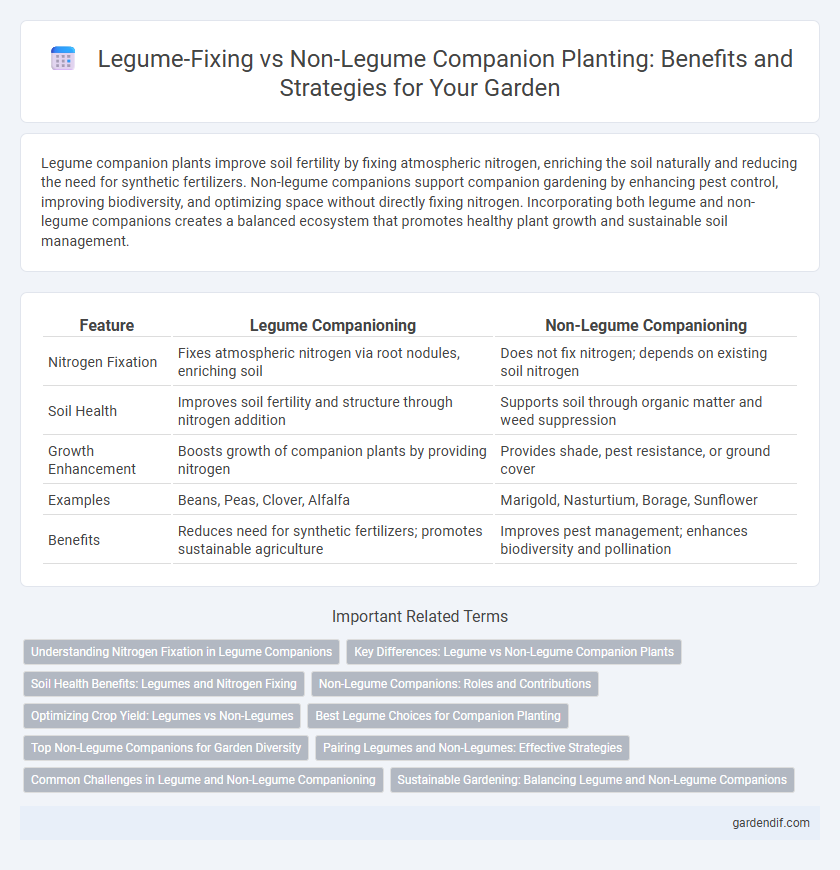
Legume fixing vs non-legume companioning Illustration
Legume companion plants improve soil fertility by fixing atmospheric nitrogen, enriching the soil naturally and reducing the need for synthetic fertilizers. Non-legume companions support companion gardening by enhancing pest control, improving biodiversity, and optimizing space without directly fixing nitrogen. Incorporating both legume and non-legume companions creates a balanced ecosystem that promotes healthy plant growth and sustainable soil management.
Table of Comparison
| Feature | Legume Companioning | Non-Legume Companioning |
|---|---|---|
| Nitrogen Fixation | Fixes atmospheric nitrogen via root nodules, enriching soil | Does not fix nitrogen; depends on existing soil nitrogen |
| Soil Health | Improves soil fertility and structure through nitrogen addition | Supports soil through organic matter and weed suppression |
| Growth Enhancement | Boosts growth of companion plants by providing nitrogen | Provides shade, pest resistance, or ground cover |
| Examples | Beans, Peas, Clover, Alfalfa | Marigold, Nasturtium, Borage, Sunflower |
| Benefits | Reduces need for synthetic fertilizers; promotes sustainable agriculture | Improves pest management; enhances biodiversity and pollination |
Understanding Nitrogen Fixation in Legume Companions
Legume companions enhance soil fertility through biological nitrogen fixation, a process where root nodules convert atmospheric nitrogen into plant-usable forms, boosting nutrient availability. Unlike non-legume companions, which rely solely on soil nitrogen, legumes reduce the need for synthetic fertilizers by enriching the soil naturally. This symbiotic relationship with Rhizobium bacteria plays a vital role in sustainable agriculture and crop rotation practices.
Key Differences: Legume vs Non-Legume Companion Plants
Legume companion plants enhance soil fertility by fixing atmospheric nitrogen through root nodules, benefiting nearby crops with increased nitrogen availability. Non-legume companion plants do not fix nitrogen but improve plant health by providing pest control, shade, or structural support. The key difference lies in legumes' unique symbiotic relationship with nitrogen-fixing bacteria, making them crucial for natural soil enrichment in companion planting systems.
Soil Health Benefits: Legumes and Nitrogen Fixing
Legume companions enhance soil health by fixing atmospheric nitrogen through symbiotic bacteria in root nodules, enriching soil fertility and reducing the need for synthetic fertilizers. Non-legume companions contribute organic matter and improve soil structure but do not fix nitrogen. Integrating legumes into crop rotations or polycultures promotes sustainable soil nutrient cycling and supports plant growth by naturally increasing soil nitrogen content.
Non-Legume Companions: Roles and Contributions
Non-legume companions enhance soil structure and pest control by supporting beneficial insect populations and improving root aeration. They contribute essential nutrients through mulching and organic matter decomposition, promoting overall plant health without nitrogen fixation. Integrating non-legume companions with crops increases biodiversity, reduces disease incidence, and supports sustainable agricultural ecosystems.
Optimizing Crop Yield: Legumes vs Non-Legumes
Legume companions enhance crop yield by fixing atmospheric nitrogen through root nodules, enriching soil fertility and reducing the need for synthetic fertilizers. Non-legume companions improve yield primarily by pest repulsion, weed suppression, and microclimate modification, contributing to healthier crop growth without direct nitrogen input. Combining legumes with non-legumes leverages complementary benefits, optimizing overall nutrient availability and crop productivity in sustainable agriculture systems.
Best Legume Choices for Companion Planting
Pea, clover, and vetch are among the best legume choices for companion planting due to their nitrogen-fixing abilities, which enhance soil fertility and promote the growth of non-legume companion plants like tomatoes and corn. These legumes enrich the soil by converting atmospheric nitrogen into a form accessible to plants, reducing the need for synthetic fertilizers. Selecting legumes with robust root systems and compatibility with target crops maximizes growth benefits and pest resistance in companion planting setups.
Top Non-Legume Companions for Garden Diversity
Top non-legume companions such as marigolds, nasturtiums, and sweet alyssum promote garden diversity by attracting beneficial insects and deterring pests without nitrogen fixation benefits typical of legumes. These plants enhance soil health indirectly through pest control and pollinator support, complementing nitrogen-fixing legumes in a balanced garden ecosystem. Incorporating a variety of non-legume companions increases biodiversity, resilience, and overall productivity in mixed planting systems.
Pairing Legumes and Non-Legumes: Effective Strategies
Pairing legumes with non-legumes enhances soil nitrogen levels through biological nitrogen fixation, reducing the need for synthetic fertilizers and promoting sustainable agriculture. Effective companion planting strategies involve selecting compatible species such as beans with corn or peas with carrots, which optimize nutrient use and pest management. These combinations improve overall crop yield and soil health by leveraging the complementary growth habits of legumes and non-legumes.
Common Challenges in Legume and Non-Legume Companioning
Legume companion planting enhances soil nitrogen through symbiotic fixation, yet challenges include managing competition for sunlight and water among diverse species. Non-legume companioning often struggles with nutrient depletion and allelopathic effects, which can inhibit growth of neighboring plants. Both systems require balanced planting strategies to mitigate pest pressure, optimize resource use, and ensure crop compatibility for sustainable yields.
Sustainable Gardening: Balancing Legume and Non-Legume Companions
Legume companion plants enhance soil fertility through nitrogen fixation, reducing the need for synthetic fertilizers and promoting sustainable gardening practices. Integrating non-legume companions complements this benefit by improving pest control, nutrient diversity, and soil structure, creating a balanced ecosystem. This synergy between legume and non-legume companions supports healthier plant growth, increased biodiversity, and long-term garden sustainability.
Legume fixing vs non-legume companioning Infographic

 gardendif.com
gardendif.com